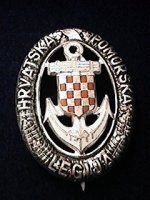
By Allen Milcic
Introduction and History
On December 1, 1918, the Kingdom of Serbs, Croats and Slovenes was proclaimed. This political creation of the Treaty of Versailles was purely an award to the Kingdom of Serbia for its participation in World War I on the side of the Allied powers. The new country was, in theory, to unite the Southern Slav peoples of the Balkans (except for the Bulgarians) into an equal federation under the rule of the Serbian Royal family. In reality it was completely dominated by Serbia, which treated all of the other nations in the country as vassals or colonies. Part of this new state was Croatia, whose people had enjoyed a great deal of autonomy under the rule of the Austro-Hungarian Empire until its dissolution at the end of Word War I. The Croats were not asked whether they were interested in joining this new state, this was decided and imposed upon them.
Resistance by the Croats was at first peaceful and expressed through available legal means, through political dialogue, and through passive resistance. The Serbian response to this was the assassination of the Croatian political leader, Stjepan Radic, in the parliament building at Belgrade. Amazingly, this crime was further embellished by the abolition of the country's constitution in 1929, and the establishment of an absolutistic dictatorship by the Serbian King. At this time, the country was also re-named "Yugoslavia".
The dictatorship caused the creation of a Croatian separatist group – the "Ustasha" (roughly translated as "Upriser"). Led by Dr. Ante Pavelic, a Croatian lawyer, the Ustashe demanded an independent homeland for the Croatian people. They received financial and military assistance from Fascist Italy and Hungary, both of whom were hungry for a piece of Yugoslavia. The Ustashe organized an armed insurgency against the Yugoslav government, and commenced with an assassination and bombing campaign. In 1934, they managed (with the help of a Macedonian anti-Yugoslav party, the VMRO) to assassinate Yugoslavian King Aleksander, while he was in Marseilles, France.
On April 6, 1941, Germany invaded Yugoslavia and most of the population of Croatia greeted the Germans as liberators. The Ustashe took the opportunity, and on April 10, 1941, while the battles for Yugoslavia were still being waged, retired Colonel and secret Ustasha Slavko Kvaternik announced in Zagreb (Croatian capital) the formation of an "Independent State of Croatia" (Nezavisna Drzava Hrvatska, in the Croatian language - "NDH"). Ante Pavelic was declared the "Poglavnik" (Leader) of the new state, while Kvaternik became the Commander-in-Chief of the Croatian Armed Forces (of course, at that time still non-existant). On the next day, April 11, 1941, an order creating the "Hrvatsko Domobranstvo" (Croatian Homedefense) was issued. The Domobranstvo was to consist of an Army, Navy, Airforce, Gendarmerie, Railway Security and Labour Service. The Ustasha Party also formed an armed wing (a Croatian version of the Waffen SS) called the "Ustashka Vojnica". The Ustashe were highly motivated (mostly volunteers), and quickly earned a reputation for fanatical bravery, as well as brutality. They never gave, nor asked, for mercy.
From the very beginning, the Croatian military was plagued by a lack of equipment and weapons, specially heavy weapons and armor. Artillery battalions had, for example, only 2 batteries, instead of the usual 3-4 batteries. Armored units were few and armed only with a few tankettes and armored cars (they had almost no modern tanks). The meddling of Italy in Croatian affairs, poor Italian military efforts in their assigned area in southern Croatia, and Italian support for Royalist Serbian Cetniks in Croatia, posed a serious problem to the Croatian military. Another major problem for the Croatian military forces was the mass exodus of many of the best Croatian officers, NCO's and soldiers to foreign (Axis) armies. Croatia had an infantry regiment, an air and a naval legion fighting on the Eastern Front as part of the German Wehrmacht. Three German infantry divisions were also manned by Croatian volunteers, as were two Waffen SS Divisions and an SS Police Division. The Italians also formed 2 "Legions", staffed with Croatians.
The Domobranstvo was re-organized twice after the initial set-up, this happening on November 1, 1941 and on May 1, 1943. Many new units are formed, re-formed, organized, and disbanded in this time period. On November 20, 1944, the Domobranstvo and the Ustashka Vojnica were amalgamated into the "Croatian Armed Forces" (Hrvatske Oruzane Snage). This was in a large part in order to bolster Domobran moral, as well as place faithful Ustashe amongst potential "weak links", as a form of "motivation".
On May 6, 1945, with the German Army in full retreat, the Partisans taking town after town, and the Red Army swarming accross the borders, the Croatian government leaves Zagreb. Along with the remnants of the Croatian Armed Forces (approximately 200,000 troops), they retreat towards Austria in hopes of surrendering to the British. At the town of Bleiburg, Austria, the Croatians finally surrender to the British between May 15 and May 17, 1945, becoming the last European Axis army to capitulate. The British promptly returned the Croatians to Yugoslavia, and to certain death in the hands of Tito's bands of Communist partisans. The military of tiny Croatia in WW2, despite the lack of proper arms, despite fighting against a formidable anti-Fascist guerilla opponent (partisans) and a strong Serbian nationalist army (the Cetniks), and despite a meddling Italy, managed to field an army that fought hard, and to the bitter end.
1.Croatian Units on the Eastern Front:
1.1.: The 369th Reinforced (Croat) Infantry Regiment:
This Wehrmacht (Heer) unit of Croatian volunteers was raised in July, 1941, for combat on the Eastern Front. This was an infantry regiment with 3 infantry battalions and its own artillery attached (therefore “reinforced”). From October 9, 1941, the regiment was attached to the 100th Jaeger Division, and fought some major engagements at Harkov, Kalatch and Selivanov. The Croatians proved to be reliable and brave soldiers, and were held in high regard by both the German command and their German comrades in arms. On September 29, 1942, the Regiment entered Stalingrad, where they were destroyed after a long and heroic struggle (a few survivors surrendered to the Red Army on February 2, 1943).
Approximately 6,300 Croatian soldiers served in this unit through its ill-fated existence. Many were awarded various Croatian decorations, and a high number received German decorations. This is an incomplete list:
Iron Cross 1st Class:
- - Colonel Viktor Vitez PAVICIC, commander of the 369th Regiment from July 1, 1942 - January 20, 1943. Awarded the Iron Cross 1st Class by General Sanne on October 16, 1942, at Stalingrad. The award was received for “excellent leadership of the Croatian Legionnaire unit”. Colonel Pavicic was declared “missing and presumed dead” on January 21, 1943. It is presumed that the plane that he was being evacuated from Stalingrad on was shot down. He is pictured below in Colonel's uniform of the Army (Domobranstvo) of the Independent State of Croatia, while commanding the Croatian Military Academy (his post prior to taking over the 369th Regiment).
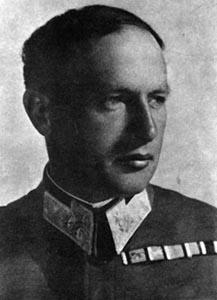
|
| Colonel Viktor "Vitez" Pavicic |
- - Staff Sergeant Dragutin PODOBNIK, recieved the Iron Cross 2nd Class on
September 24, 1942, for actions in the Ukraine, during the course of the
Summer (specifically the "Proljet Kultura" Kolhoz battle, an all-night,
hand-to-hand combat action). On September 27, 1942, the 369th entered
Stalingrad.
Staff Sergeant PODOBNIK was further decorated on October 16, 1942 with the Iron Cross 1st Class by General Sanne (at Stalingrad). The award was recieved for an action on September 30, 1942, where Podobnik and 18 of his men infiltrated a fortified Soviet position in the “Red October” factory, destroyed the defenders(even though the Russians outnumbered them), and handed over the occupied building to the 54th German Regiment (that had been unsuccessfully attacking this position for several hours). Podobnik and his men also captured 3 enemy artillery pieces, 2 mortars, 1 “Maksim” machine-gun, and a large number of rifles, pistols, grenades and automatic weapons. All of this with only 3 lightly wounded men. Sergeant Podobnik would, unfortunately, not return from Stalingrad (his actual fate is unknown).
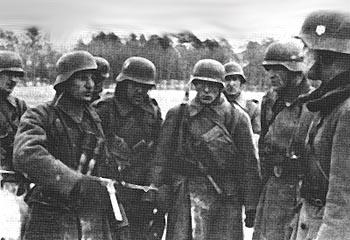
Staff Sergeant Dragutin Podobnik
(second from left with the Schmeiser sub-machine gun)
- - Lt.-Colonel Marko MESIC, commander of the regimental artillery detachmen from July, 1941. Regimental commander from January 20, 1943 - February 2, 1943. Awarded the Iron Cross 1st Class in the last days of the Stalingrad pocket, when he took over the few surviving members of the regiment, and put up a tenacious defense. He entered Soviet captivity, where he survived years of hunger and abuse, only to be turned over to the post-war Yugoslavian Communist government, who tried and executed him in 1947.
Iron Cross 2nd Class:
- - Lt. 1st Class BAKAREC received the German Iron Cross 2nd Class in October of 1941, while commanding the 11th (Bicycle) Company of the Regiment, attached to the Vorausabteilung of the 100th Jaeger Division.
- - Sergeant Ivan GRBESA was awarded the Iron Cross 2nd Class during the course of the battle for Stalingrad.
- - Captain Geza MAJBERGER, commander of the 1st Battalion, received the Iron Cross 2nd Class for leadership during the battles around Manojlin, summer of 1942. He was mortally wounded on July 30, 1942.
- - Lt. Josip ZAMBATA was awarded the Iron Cross 2nd Class in September, 1942.
- - Sergeant Dzafer BABOVIC,September, 1942.
[Note: this is an incomplete list of Iron Cross 2nd Class winners. As further
information becomes available, the list will be updated].
The survivors of the Regiment (approximately 1000 men), that were evacuated from Stalingrad via air, formed the core of a new Croatian volunteer unit of the Wehrmacht - the 369th “Vrazja” (Devil’s) Infantry Division. These veterans were awarded a commemorative badge, the “Croatian Legion 1941” Linden Leaf in silver, worn on the right breast pocket.
The "Devil's" Division (the 369th Infantry Division) fought hard battles
against the Communist Partisans throughout Croatia throughout '43, '44, and
early '45. On May 10/11, 1945, it surrendered to British forces in Austria, and
its men returned to "Yugoslavia" for trial. Most were killed.
1.2.: The Croatian Airforce Legion:
 |
| Croatian Airforce Legion Badge |
This Luftwaffe unit of Croatian volunteers was formed on June 2, 1941, and had a fighter and a bomber squadron. The fighter squadron was designated ‘15.(Kroatische)/JG 52’, and served on the Eastern Front with great success from October 6, 1941 - July, 1944. The bomber squadrom was titled ‘15.(Kroatische)/KG 53’, and served on the Eastern Front from October 25, 1941 - December of 1942.
Decorations received by the Legion were as follows:
Fighter Squadron:
- - Lt.-Colonel Mato CULINOVIC, Iron Cross 1st and Iron Cross 2nd Class;
- - Lt. Cvitan GALIC, Iron Cross 1st and Iron Cross 2nd Class;
- - Sergeant Veca MILKOVIC, Iron Cross 1st and Iron Cross 2nd Class;
- - Sergeant Tomislav KAUZLARIC, Iron Cross 1st and Iron Cross 2nd Class;
- - 40 other members of the Fighter Squadron received the Iron Cross 2nd Class.
Bomber Squadron:
- - 150 members of the Bomber Squadron received the Iron Cross 1st and/or 2nd Class.
Croatian Airforce Legion Badge was worn by members of the Legion while on the Eastern Front. The pilots were allowed to continue wearing these badges upon the disbandment of their legions, and assignment to Croatian military units.
1.3. The Croatian Naval Legion:
|
|
| Croatian Naval Legion Badge |
This Kriegsmarine unit of Croatian volunteers was formed in July, 1941, and
served in the Black Sea until October, 1943.
A total of 343 men served in this unit, performing security, minesweeping and small vessel combat missions. Frigate Captain Andro VRKLJAN (the Legion’s first commander) was awarded the Iron Cross 1st Class. 50 other members of the Legion were decorated with the Iron Cross 2nd Class.
With the surrender of Italy in 1943, the Italian veto on a Croatian Navy in the Adriatic Sea became null and void, so the Croatian sailors were returned to Croatia for further service.
Croatian Naval Legion Badge was worn by members of the Legion while on the Eastern Front. The seamen, like their pilots counterparts, were allowed to continue wearing these badges upon the disbandment of their legions and assignment to Croatian military units.
Croatian Awards
As detailed above, the Independent State of Croatia (Nezavisna Drzava Hrvatska or NDH) was
founded on April 10, 1941. Over the course of its existence (until May 8, 1945),
the state established 43 different military decorations. The first decorations
were established and granted on May 15, 1941 (these were the 4 classes of the
Crown of King Zvonimir). The last decoration was established October 14, 1943.
The following are the most important of the Croatian decorations:
1. THE MILITARY ORDER OF THE IRON TREFOIL:
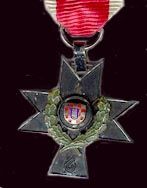
The highest attainable Croatian military decoration, the Order of the Iron Trefoil was founded on December 27, 1941. It was awarded to soldiers or officers of the Croatian Armed Forces and the Ustase for “exceptional gallantry, leadership and acts of bravery against the enemy”. “Members of allied or friendly armed forces could receive this Order for assisting in the achievement of Croatian independence, or for acts of heroism when fighting in concert with Croatian forces”. The Order was in 4 classes, and each class could “for outstanding acts of bravery” have a green (enamel) wreath added in its center. The Order itself was shaped as a Croatian trefoil, made of black iron with narrow silver edges. The “leaves” of the trefoil were decorated with the Croatian braid in silver. In the middle of the trefoil was a Croatian crest (red-white checkerboard), superimposed with the letter “U” (Ustase) in blue. The obverse had the words “Za Dom Spremni” (ready to defend the Fatherland) and the date 10. IV. 1941. engraved.
2. THE GRAND ORDER & THE ORDER OF THE CROWN OF KING ZVONIMIR:
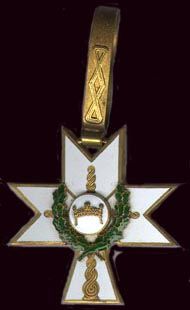
The second highest Croatian military decoration, the Order of the Crown of King Zvonimir was established on May 15, 1941. I was awarded to members of the Croatian Armed Forces, the Ustase, or to members of allied and friendly forces, the Order came in 4 classes, and could have a star, oak leaves and swords added for “exceptional or outstanding achievements”. The Grand Order of the Crown of King Zvonimir was founded at a later date as the highest decoration within this Order (the star, swords or oak leaves could also be added). The decoration itself was shaped as a Croatian trefoil in white enamel, with golden edges, golden Croatian braids in the leaves, and a golden crown in the center. The obverse had the years 1076 (date of King Zvonimir’s ascension to the Croatian throne) and 1941 (date the NDH was founded), and the words “Bog i Hrvati” (God and the Croats) written in gold lettering.
3. THE MEDALS OF THE CROWN OF KING ZVONIMIR:
These medals came in silver and in bronze, and could have oak leaves added for “exceptional acts”. Awarded to members of the Croatian Armed Forces, Ustase or members of allied and friendly nations armed forces. A round medal with the likeness of King Zvonimir engraved. The crown of the king above the round portion.
4. THE GRAND ORDER AND THE ORDER FOR MERIT:
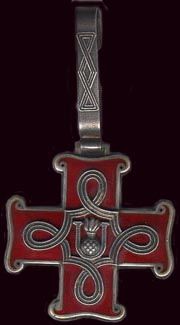
This Grand Order and Order came in 2 different shapes, a cross for the Catholic Croatians, and a 6 pointed star for Muslim Croatians. Also, different sizes existed for male and female recipients. The Order itself came in 4 classes, with a Grand Order added as the highest form. These decorations could be received by any citizen of the Independent State of Croatia, for “acts of heroism, or for advancing the cause of Croatian independence”. As stated, the Catholic Croatian Order was shaped as an even sided cross, in red enamel, with silver edges, a Croatian braid, and an Ustase crest in the center (also in silver). The Muslim Croatians received a six-sided star in red enamel, intertwined with a braid in silver, with the Ustase crest in the center (in silver). order of Merit for Christians 2nd Class
5. THE ANTE PAVELIC MEDALS FOR BRAVERY:
These medals came in gold, silver or bronze, and were given for “acts of bravery in the face of the enemy” to members of the Croatian Armed Forces or the Ustase. The medals themselves were round, with the likeness of Poglavnik Ante Pavelic engraved.
6. DECORATIONS FOR THE WOUNDED:
These decorations came in iron, bronze, silver and gold, and were awarded for the first, second, third and fourth wound.
NOTE: The following Croatian decorations gave the awarded the right to carry
the title of “Vitez” (Knight):
1. The Iron Trefoil 1st Class with Oak
Leaves;
2. The Iron Trefoil 1st Class;
3. The Grand Order of the Crown
of King Zvonimir with Star and Oak Leaves;
4. The Grand Order of the Crown
of King Zvonimir with Star and Swords;
5. The Grand Order of the Crown of
King Zvonimir;
6. The Ante Pavelic Medal for Bravery in gold;
7. The
Iron Trefoil 2nd Class with Oak Leaves;
8. The Iron Trefoil 2nd Class;
9. The Order of the Crown of King Zvonimir 1st Class with Star and Oak
Leaves;
10. The Order of the Crown of King Zvonimir with Star and Swords;
11. The Order of the Crown of King Zvonimir with Star.
![]()
© Copyright Wehrmacht-Awards.com LLC |
